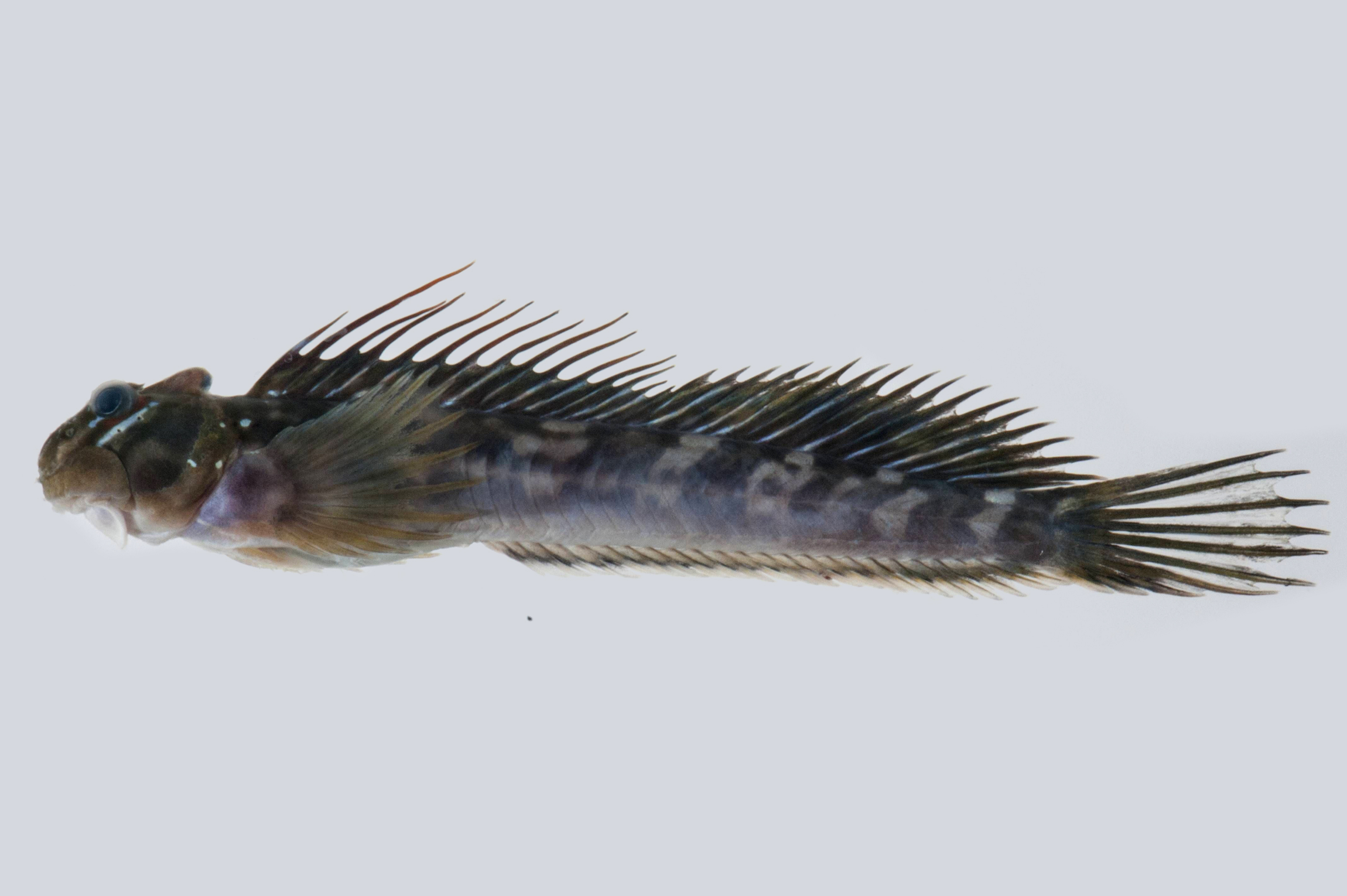Suckerlip Blenny, Andamia reyi (Sauvage 1880)
Other Names: Lipsucker Blenny, Rey's Lipsucker

A Suckerlip Blenny, Andamia reyi, from Maricaban Island, Batangas, Philippines - USNM 431998. Source: Jeffrey T. Williams / Smithsonian Institution, National Museum of Natural History, Division of Fishes. License: CC BY Attribution-Noncommercial-ShareAlike
Summary:
Unusual slender blennies with a suction disc on the lower lip that allows them to cling to wet rocks out of the water on very exposed shorelines. Suckerlip Blennies are greyish with broad chevron-shaped bars on the sides, a diagonal white line behind the eye, and pale spots along the back.
Cite this page as:
Dianne J. Bray, Andamia reyi in Fishes of Australia, accessed 06 Jul 2025, https://fishesofaustralia.net.au/home/species/4975
Suckerlip Blenny, Andamia reyi (Sauvage 1880)
More Info
|
Distribution |
Recorded from the Australian territory of Christmas Island in the Indian Ocean. Occurs elsewhere in the tropical; east-Indo-west Pacific. Individuals occur in small groups on steep wet rocks exposed to wave action. |
|
Features |
Dorsal fin XIV-XV, 19-20; Anal fin II, 23-24; Pectoral fin 15; Pelvic fin I, 4. Body elongate, depth at anal fin origin 7.8-8.2 in SL; occipital crest present in males; eye tentacle small and branched. Mouth with numerous movable jaw teeth; lips with a crenulated margin, lower lip with a fleshy cup-shaped disc. Dorsal-fin spines with filamentous tips, second spine elongated particularly in males; last anal-fin ray bound to caudal fin by a membrane; caudal-fin rays unbranched. |
|
Remarks |
The three species in the genus Andamia, A. heteroptera, A. reyi and A. tetradactylus, are currently confused taxonomically and distributional limits are u.ncertain (Williams 2014) |
|
Species Citation |
Salarias reyi Sauvage, 1880, Bull. Sci., Soc. Philomath. Paris 4: 219. Type locality: Luzon Island, Philippines. |
|
Author |
Dianne J. Bray |
|
Resources |
Suckerlip Blenny, Andamia reyi (Sauvage 1880)
References
Allen, G.R. & Erdmann, M.V. 2012. Reef fishes of the East Indies. Perth : Tropical Reef Research 3 vols, 1260 pp.
Allen, G.R. & Steene, R.C. 1988. Fishes of Christmas Island Indian Ocean. Christmas Island : Christmas Island Natural History Association 197 pp.
Allen, G.R., Steene, R.C. & Orchard, M. 2007. Fishes of Christmas Island. Christmas Island : Christmas Island Natural History Association 2 edn, 284 pp.
Kishimoto, H. 1997. New records of two coral reef fishes, Callechelys marmoratus (Anguilliformes: Ophichthyidae) and Andamia reyi (Perciformes: Blennidae), from Japan. Bulletin of the Institute of Research and Development (Tokai University) 18: 17-22.
Patzner, R.A., E.J. Gonçalves, P.A. Hastings & B.G. Kapoor (eds.) 2009. The biology of blennies. Enfield, NH : Science Publishers, 482 pp.
Rao, S. 1939. The rock-skipping fishes of the genus blenniid Andamia from the Andamans. Current Science 8: 228.
Sauvage, H.E. 1880. Description de quelques Blennioïdes de la collection du Muséum d'histoire naturelle. Bulletin des Sciences, par la Société Philomathique de Paris 4: 215-220.
Shen, S.-C., Yang, T.-H. & Lin, J.J. 1986. A review of the blenniid fishes in the waters around Taiwan and its adjacent islands. Taiwan Museum Special Publications Series 5: 1-74.
Smith-Vaniz, W.F. & Springer, V.G. 1971. Synopsis of the Tribe Salariini, with description of five new genera and three new species (Pisces : Blenniidae). Smithsonian Contributions to Zoology 73: 1-72 figs 1-50
Springer, V.G. 2001. Blenniidae. pp. 3538-3546 in Carpenter, K.E. & Niem, T.H. (eds). The Living Marine Resources of the Western Central Pacific. FAO Species Identification Guide for Fisheries Purposes. Rome : FAO Vol. 6 pp. 3381-4218.
Watson, W. 2009. Larval development in blennies. pp. 309-350. In Patzner, R.A., E.J. Gonçalves, P.A. Hastings & B.G. Kapoor (eds.) The biology of blennies. Science Publishers, Enfield, NH, USA. 482 pp.
Williams, J.T. 2014. Andamia reyi. The IUCN Red List of Threatened Species. Version 2014.3.





